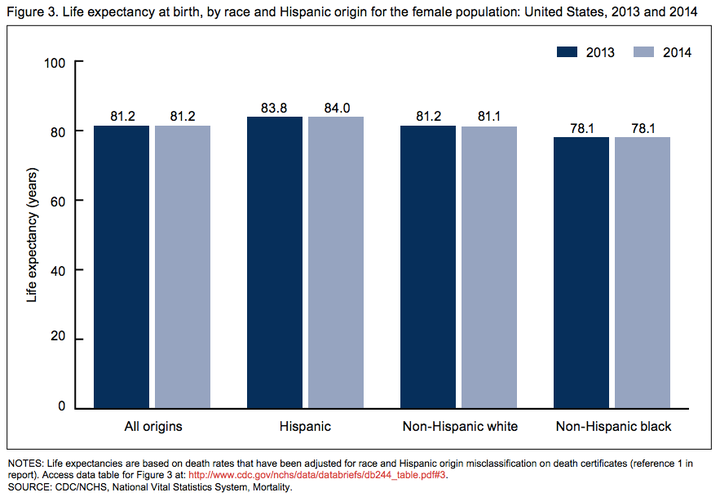
Five months ago, a report made waves with the finding that middle-aged white Americans are dying earlier, and at markedly higher rates -- a demographic health reversal only seen in the U.S.
Specifically, this increase in mortality rates was linked to increases in deaths from drugs, alcohol and suicide, especially among whites with less education.
But critics who re-analyzed the numbers and separated men and women found that this increase in death rates only applied to white women, not white men. And a new analysis by the U.S. Centers for Disease Control and Prevention’s National Center for Health Statistics affirms this view.
From 2013 to 2014, white women's life expectancy decreased from 81.2 years to 81.1 years, according to the NCHS. This means that a group of white baby girls born in 2014 can expect to live to about 81.1 years old, provided that the death rates observed in 2014 don't change over their lifetimes.
Don’t be fooled by the seemingly small decrease of one-tenth of a year in life expectancy, said study author Elizabeth Arias, a demographer at NCHS. It’s rare to see any change in either direction beyond one- or two-tenths of a year. And if the negative trend continues over time, those lost months could stack up fast.
“It’s significant,” said Arias. “Especially year after year, if you have one-tenth of a year’s increase [in mortality] every year, that adds up."
Meanwhile, the NCHS also found that life expectancy rates rose from 2013 to 2014 among black men and all Hispanics, and were stable among black women and white men. As a group, Hispanics have historically enjoyed the highest life expectancy rates since the CDC started compiling these stats in 2006, and their gains continued.
Blacks, on the other hand, have had the lowest life expectancies, but the gap that separates them from whites continues to shrink.
According to experts, this increase in mortality rates is a sign that white women -- and especially poor, less-educated white women -- are being left behind in American society.

White women may be more likely than white men to feel the effects of low education and poverty.
Arias didn't publish any information on causes of death that could explain the life expectancy decrease in white women, but she said yet-unpublished data from the NCHS indicates that increases in deaths from accidents, unintentional injury (mainly from drug and alcohol poisoning), suicide, chronic liver disease and cirrhosis could have played a role in the decline.
These are the same causes of death that husband-and-wife economists Angus Deaton and Anne Case blamed in their splashy 2015 analysis of American life expectancies -- the aforementioned report that found that mortality rates for middle-aged white people with less than a college education rose from 1999 to 2013, usually due to suicide and complications related to drug and alcohol use disorders.
Andrew Gelman, a statistician at Columbia and one of researchers who re-analyzed Deaton and Case’s study, said Arias’ analysis -- that the decrease is among white women only -- is consistent with a paper he and student Jonathan Auerbach published in 2015. It found the age-adjusted death rates for white women seemed to increase, especially in the South.
"This result appears consistent with what Auerbach and I found in our recent [study], where we noted an increasing trend in the age-adjusted death rates of middle-aged white women, but not white men,” Gelman told HuffPost.
Arias says her findings are consistent with both interpretations of Deaton and Case’s data, not only because the causes of death may be similar, but also because she actually did find a small decrease in life expectancy for men. However, this decrease was so small that it isn’t reflected in the final, rounded numbers.
“What we’re finding is consistent with what was published by Case and Deaton, and by others who argue that it affects females more than males,” she said.
White women are left behind
Jarron Saint Onge, a health policy and sociology expert at the University of Kansas, has yet another idea about white women’s declining life expectancy: that the numbers are being driven down by the poor members of the group.
He points to a 2016 study on life expectancy and income in the U.S. published in the journal JAMA. It found that middle-aged women of all races who are at the bottom one percent of the income curve have an expected death age of 78.8 years, while their peers in the top one percent had an expected death age of 88.9 -- more than ten years longer.
Saint Onge also said that the biggest drops in life expectancy for women of all races are in rural Southern states with high rates of unemployment, disability, diabetes and smoking. Women in such places might be the primary breadwinners in the family, as well as the person who does most of the childcare, housework and cooking, said Saint Onge. This adds to life stress, which can be harmful for health.
And while the CDC’s analysis doesn’t break down the data by education, the decline in white women’s life expectancies could also be explained by a 2012 study that found that white women who dropped out of high school are expected to die five years earlier than the generation that preceded them.
Taken altogether, Saint Onge says, this points to an ugly present and future for poor, poorly educated white women.
“Broad scale economic and social shifts have left less-educated white women behind,” said Saint Onge. “They tend to be more socially isolated compared to ethnic minorities, have fewer opportunities for marriageable partners (important for both economic resources, health insurance and social resources) and tend to live in poorer neighborhoods."
Hispanics tend to be poorer and have less education and health insurance than the general U.S. population. But unlike poor, less-educated white women, they have lower smoking rates, stronger family ties and a strong sense of community that may help them lead longer, healthier lives. They maintained their reign as the group with the highest life expectancy, increasing by two-tenths of a year between 2013 and 2014, according to Arias’ analysis.
It should be noted, however, that the high life expectancies of Hispanics could also be influenced by the fact that many are young, healthy immigrants who end up returning to their home countries when they’re elderly or infirm.
How to fix this problem
If future research confirms that lower life expectancies are concentrated among poor, less-educated white women, big policy changes that broaden access to education and jobs, as well as programs to help decrease substance abuse disorders among working class whites, will be needed to turn the tide, says Saint Onge.
There are signs that this is already happening. President Barack Obama announced in March a comprehensive administration initiative to inject $94 million in new funding for substance use disorder treatment services in community health centers and $11 million in funding for states to buy and distribute naloxone, the drug that reverses opioid overdoses. The Obama administration will also reach out to doctors to encourage them to rethink the way they prescribe opioid pain killers because of their link to overdose and heroin use.
“At its core, [the increasing mortality rates of white women] is really a big structural issue about access to education and healthy environments along with the risk of poverty,” said Saint Onge. "I believe the answer is really about providing educational and employment opportunities, and reducing the suffering and negative coping strategies that frequently result from the lack of opportunities."
